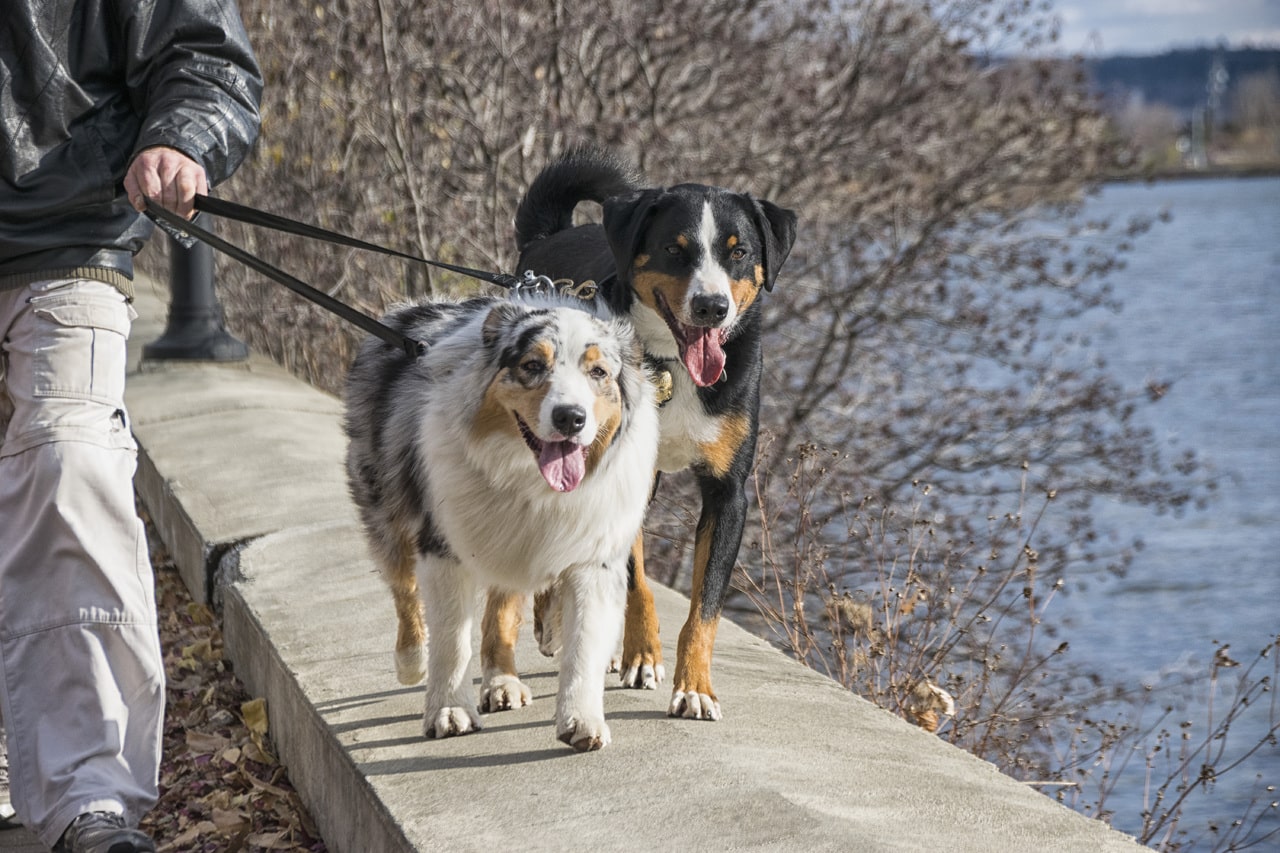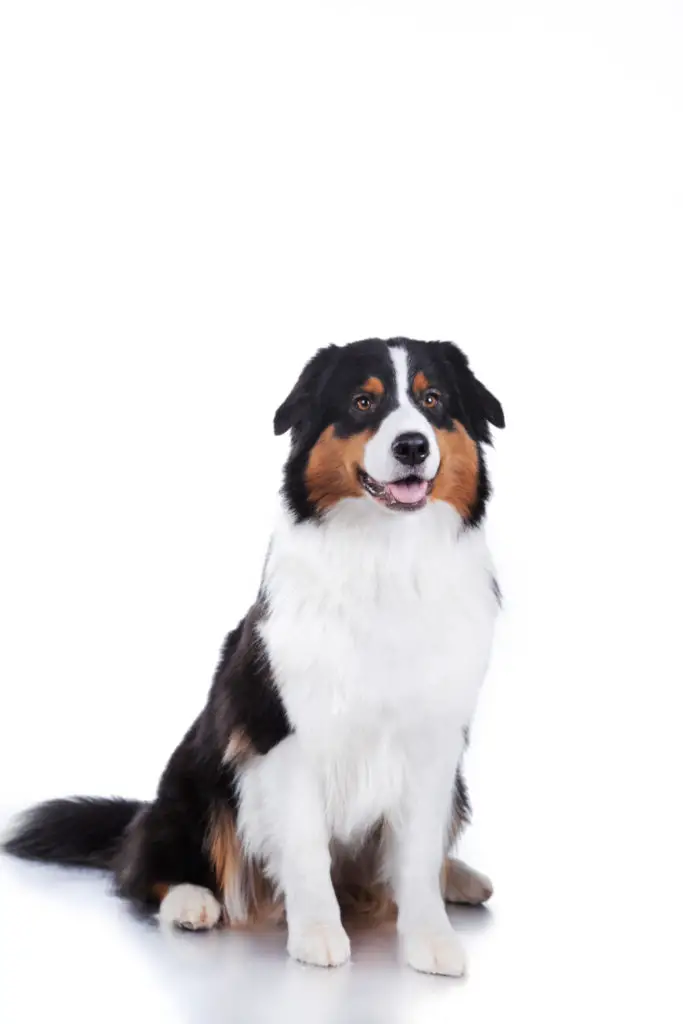Training An Australian Shepherd To Walk On A Leash
Pet Cosset may receive some form of compensation from the links on this page, at no extra charge to you. Learn more.
Australian Shepherds are intelligent canines. However, they can get a handful, too, when they are brought outdoors. Training an Australian Shepherd to walk on a leash is important so that you can take them outside without any worries. For this training drill, you need the right leash, collar, and some patience to teach your Aussie how to heel by your side.

Finding the right harness and leash for your Australian Shepherd
The first step to teaching your Aussie to walk on a leash is to get the right equipment. Unlike typical leashes for walking, you need a shorter dog leash for training (Check on Amazon). This short length will keep your Australian Shepherd in the heeling position. please read here do australian shepherds shed

Also, you wouldn’t want to give your dog too much freedom when training it to walk on a leash. The shorter lead will also give you more control of your Australian Shepherd whenever it gets distracted and tries to run away.
Meanwhile, you should consider a harness instead of a collar when training an Australian Shepherd. This is a large breed, and a collar may only hurt their necks when the doggo tries to pull. A large dog harness (Check on Amazon) will serve your Aussie well, even on other training drills.
Always invest in a harness that will grow with your Australian Shepherd. This dog grows big and fast, so you must think ahead when buying their accessories, even if they are still puppies. please read here how to tell if a dog has had puppies
How to train an Australian Shepherd to walk on a leash
Training your Australian Shepherd to walk on a leash doesn’t happen overnight. You have to be patient and consistent to ensure that your doggo will learn the command properly. Never punish your Aussie for pulling, tugging, or trying to get off the leash. These are common problems with workarounds that I discussed below.
To get started on training your dog, I suggest these three different methods. Feel free to try each one to find which works for your Aussie best.

Method 1: Heeling with treats
There’s no question that dogs are food-driven. You can use their love of food to get what you want. For this part, you need some yummy and smelly training treats (Check on Amazon). Here’s how this training goes:
- Get some yummy treats and keep it on your other hand while the other holds the leash.
- For large treats, divide it into smaller pieces. You’d be rewarding your Aussie many times in this process.
- With your Australian Shepherd on a leash, start walking in your yard.
- The moment your Aussie pulls the leash, tug the leash slightly and say the cue word ‘heel!’.
- Stop walking and wait until your Australian Shepherd stops pulling.
- The moment your dog comes back to your side, give it one of the treats.
- If the pooch doesn’t come back, call its name and show the treats on your hands as a lure.
- When he comes, give a treat.
- Repeat this process and increase the distance you’re walking around your yard. Later on, you can introduce distractions like toys and other people.
Method 2: Indoor leash training
If your Australian Shepherd is a nervous and easily distracted canine, you may want to start training indoors. Once your doggo mastered the basics, you can bring it outdoors to level up its leash training. In the meantime, you can perform these steps at home:
- Remove any distractions at home that may catch your Australian Shepherd’s attention.
- Start walking your leashed Aussie on a hallway leading to the door.
- If the pooch jumps in excitement at the door, say a firm ‘No!’ then walk back to your starting point.
- Sit down and let your dog calm down before continuing with the training.
- Walk your leashed Aussie again and reward it when it stops calmly by the door. Walk back and reward again at the starting point.
- If your Australian Shepherd tugs or pulls the leash, call its name and reward when it comes.
- Repeat this process until your Australian Shepherd walks on a leash without pulling.
- You can also try this drill on different parts of your home as a way to ‘proof’ the leash training. please read here what is the hardest dog to potty train
Method 3: Reward and consequence
The last method I recommend is what I call ‘Reward and Consequence’. It’s a basic utilization of positive reinforcement while teaching your dog that pulling the leash doesn’t give it what it wants. For this method, here’s what you need to do:
- Take your Australian Shepherd in your yard and start walking it on a straight line.
- If your Aussie tries to pull, tug the leash in the opposite direction.
- After that, walk your dog to the direction opposite to where it’s tugging.
- Once your Aussie is heeling beside you again, give it a treat and lots of praises.
- Repeat this and keep walking the opposite direction when your Aussie tugs the line.
- Over time, your dog will realize that tugging has consequences and that heeling comes with rewards.
Potential problems when training an Australian Shepherd
Training your Australian Shepherd to walk on a leash is not one without some problems. Like any dog, your Aussie will try to get its way. Fret not, because there are workarounds you can do to fix this problem. The following are some of it:

- Tugging and pulling. Australian Shepherds are active dogs so expect that they will tug and pull to go where they want. This is common among canines and can be solved through proper positive reinforcement. Punishing your dog for pulling will only make matters worse. Instead, lure the pooch with smelly treats then reward it for coming back to your side.
- Not answering to commands. Aussies can be pretty stubborn, especially in their puppy period. Nevertheless, food is your bosom buddy in this situation. No puppy can resist a tasty treat, no matter how much it wants to go somewhere. You can also use squeaky toys and other things your dog can’t resist.
- Chewing the leash. Some Australian Shepherd will turn on the leash and try to chew it off. It can be due to playfulness or frustration. Stopping and waiting for your dog to calm down will help here. Don’t forget to reward your Aussie once it stops chewing the leash.
Additional tips when leash training an Australian Shepherd
For better chances of success in leash training, you should also keep the following things in mind:

- Keep the leash short. Too much slack is too much freedom for a dog that’s being leashed trained. You should only allow a few inches of slack, which is just enough to keep your dog comfy walking by your side.
- Don’t tug too strong. There’s a fine line between a gentle tug and dragging your Australian Shepherd. No matter how frustrating it can be, be patient and use a gentle force to get your dog’s attention.
- Keep it short. Australian Shepherds, or any dog, don’t do well on extended leash training sessions. It will bore your dog and make it skittish. A 5-minute leash training session would be enough. The key here is short but multiple sessions throughout the day.
- Don’t train an excited dog. If your Australian Shepherd is jumpy, nervous, or too excited, let it calm down first. Leash training a neurotic dog is a waste of effort. It’s best to sit with your dog and wait for it to simmer down.
- Be consistent. Australian Shepherds are intelligent canines. This is why you should always remain consistent with what’s acceptable or not. Otherwise, your dog will try to test you and get its way. It’s important to set the rules before you start leash training.
Conclusion
Training an Australian Shepherd to walk on a leash is a process. You should take it slow and gently. Remember, punishment and violence have no place in training and pet ownership in general. If you’re finding it challenging to teach your dog, you can always ask for professional help.
